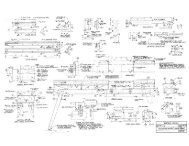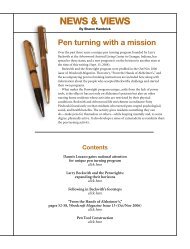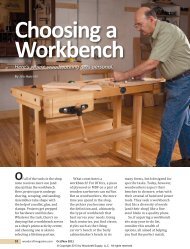42-Table Saw Safety3.indd - Woodcraft Magazine
42-Table Saw Safety3.indd - Woodcraft Magazine
42-Table Saw Safety3.indd - Woodcraft Magazine
Create successful ePaper yourself
Turn your PDF publications into a flip-book with our unique Google optimized e-Paper software.
9"<br />
5"<br />
3"<br />
C<br />
Rip the sole straight before shaping<br />
the pushstick. Complete the cut at<br />
the heel using a jigsaw or bandsaw.<br />
This ensures that stock is<br />
held to the fence when ripping<br />
and eliminates the chance<br />
of kickback once the board<br />
contacts the splitter or knife.<br />
Make sure your blade guard is<br />
in place and operating smoothly.<br />
Yes, I know a guard can get in<br />
the way when cutting narrow or<br />
small pieces, so you’re going to<br />
remove it at times. Nonetheless,<br />
use it whenever you possibly<br />
can. If you’ve “lost” your original<br />
guard, various aftermarket<br />
models can be retrofitted to most<br />
saws (see the opening photo).<br />
D<br />
When ripping, stand to the<br />
left of the blade with your legs<br />
splayed for good footing.<br />
Prepare your stock<br />
Trying to guide a crooked edge<br />
against the rip fence invites<br />
kickback. Similarly, struggling<br />
to hold a crooked edge against<br />
a miter gauge or crosscut sled<br />
fence can cause a workpiece<br />
to jump when it hits the blade.<br />
To prevent this, joint and plane<br />
stock straight and flat before<br />
bringing it to the saw. Also<br />
inspect your stock for solidity<br />
before sawing. Don’t cut through<br />
loose knots or deep cracks, which<br />
can cause parts of a board to<br />
suddenly break free mid-cut.<br />
Safe ripping basics<br />
Safe ripping requires a suitable<br />
pushstick, sure-footed balance,<br />
and a smooth, deliberate feed<br />
technique. For best control, use a<br />
“shoe-style” pushstick (Photo C).<br />
Its long sole helps hold a<br />
workpiece against the table, while<br />
its heel pushes the work forward.<br />
I make my own pushsticks from<br />
1⁄ 2"- and 1 ⁄ 4"-thick plywood, using<br />
the latter for ripping narrow<br />
stock. Make sure the sole is<br />
dead-straight for good contact<br />
with the workpiece. (Attaching<br />
a strip of 150-grit sandpaper<br />
helps for applying sideways<br />
pressure against the fence.) When<br />
sawing, keep the pushstick at<br />
the ready for easy retrieval.<br />
Make sure to use an outfeed<br />
table or other support to prevent<br />
workpieces from tipping up at<br />
the trailing end and/or crashing<br />
to the floor as you complete the<br />
cut. If using a friend as a receiver,<br />
have him support the board<br />
palms-up only, never pulling on it.<br />
To rip, stand to the left of the<br />
blade with your legs splayed<br />
roughly parallel to it and your<br />
torso facing the fence (Photo D).<br />
Turn on the saw, and lay the board<br />
Understanding Kickback<br />
So what causes kickback? It’s<br />
really pretty simple: It’s the<br />
rising rear saw teeth grabbing<br />
the edge of the board and<br />
hurling it upward and backward<br />
at fierce speeds. When ripping,<br />
the feed force encounters<br />
diagonal resistance from the<br />
blade, causing the board to<br />
rotate toward the rear teeth,<br />
instigating the problem. The<br />
fix? Use a properly aligned<br />
splitter or riving knife to keep<br />
the stock against the fence and<br />
away from the rear teeth.<br />
The<br />
Principle:<br />
Pushing<br />
against<br />
opposing<br />
corners<br />
causes<br />
board to<br />
rotate.<br />
Spinning<br />
blade<br />
Resistance<br />
from blade<br />
Kickback<br />
Rotational force<br />
drives board<br />
against rising<br />
rear teeth,<br />
which lift and<br />
throw board.<br />
40 woodcraftmagazine.com Aug/Sept 2011<br />
Feed force










